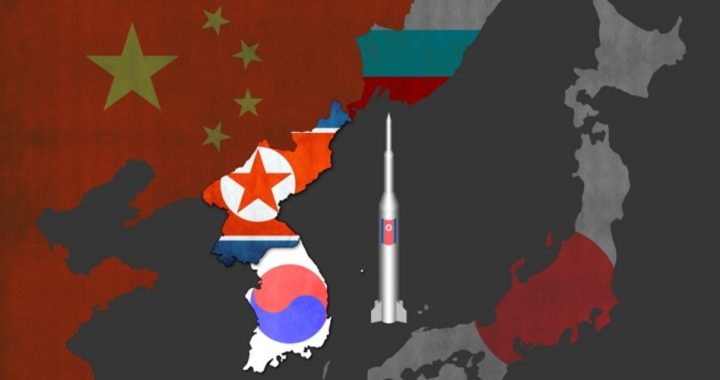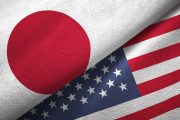
Observations of a major deployment of Russian troops and military equipment in the country’s Primorsky Krai province (the capital of which is Vladivostok) just north of Russia’s border with North Korea have raised speculations that Vladimir Putin is preparing for potential conflict owing to growing tensions in the Korean peninsula. However, the Russian government denies that the military movement is a result of the ongoing tensions between the United States and North Korea and said the maneuvers were basically routine military exercises that had been scheduled in advance.
An AP report on April 21 cited the Interfax news agency’s quote from Alexander Gordeyev, spokesman for Russia’s Far Eastern Military district, who said that the movement of heavy weaponry — captured on video and widely distributed on social media — is part of “absolutely scheduled maneuvers of combat readiness.”
Gordeyev said the military hardware was on its way back from drills elsewhere and denied any connection to the tensions that have arisen around North Korea’s nuclear program, Interfax and AP reported.
AP also cited a statement from Frants Klintsevich, the first deputy chairman of the defense committee at Russia’s Federation Council, who told the state-operated RIA Novosti news agency that the troop movement was pre-planned. Klintsevich dismissed reports suggesting that Russia was preparing for a possible U.S. attack on North Korea as “speculation.”
A report from Britain’s Sun newspaper included a link to video footage said to show one of three trains loaded with military equipment moving toward the 11 mile-long land border between Russia and North Korea, just a few miles south of Vladivostok. The report said that another scene showed military helicopters appearing to move toward the North Korean border and maneuvers across rough terrain by Russian army combat vehicles.
Other reports indicated that there have been military movements by road as well.
The Sun quoted a statement posted by the Russian website primemedia.ru, reporting: “Railway trains loaded with military equipment moving towards Primorsky region via Khabarovsk have been noticed by locals.”
Another source quoted by the Sun report was Russian military veteran Stanislav Sinitsyn, who stated, “The movement of military equipment by different means of transport to southern areas is being observed across Primorsky region over the past week. Many relate this to the situation in the Korean peninsula.”
Other countries besides Russia have apparently increased their military activity in the region. An April 21 Reuters report stated that South Korea was on heightened alert in anticipation of another important anniversary in North Korea — the 85th anniversary of the foundation of its Korean People’s Army on April 25. The report cited South Korea’s Unification Ministry spokesman, Lee Duk-haeng, who pointed out that North Korea will conclude its winter military drills at the same time as joint U.S. and South Korean military exercises, running until the end of April.
“It is a situation where a lot of exercise equipment is amassed in North Korea and also a lot of strategic assets are situated on the Korean peninsula because of the South Korea-U.S. military drills,” Lee said in a briefing.
“We are closely watching the situation,” Lee said, adding that South Korea would not let its guard down.
The report also cited a statement made by unnamed U.S. officials who said there was a higher-than-usual level of activity by Chinese bombers in the region, signaling a possible heightened state of readiness by the communist superpower. However, Beijing denied that its aircraft were on an increased level of alert. None of the U.S. officials who told Reuters about the heightened level of activity by Chinese bombers suggested alarm or signaled that they knew the precise reason for such activity.
As we reported recently, tensions between communist North Korea and the United States and its allies in the region have escalated since North Korea’s state-run Korean Central News Agency (KCNA) reported on March 7 that the nation’s launch of four missiles the previous day was part of a practice test to hone its ability to strike U.S. military bases in Japan.
While one might expect that communist China would be supportive of North Korea in any confrontation, there is a wide philosophical gap between China, whose leaders have followed the pragmatic goal of engaging in trade with the United States to bolster China’s own economic outlook, and the regime in Pyongyang, which is headed by the out-of-control petty tyrant Kim Jong-un. President Trump has repeatedly called upon the Chinese to exert whatever influence they have to rein in the rogue Pyongyang regime. On April 20, Trump praised Chinese efforts to rein in “the menace of North Korea,” after North Korean state media warned the United States of a “super-mighty preemptive strike.”
With tensions running so high, there is little wonder that every power in the region is maintaining its military on higher-than-normal alert status.
Related articles:
North Korea Threatens U.S. With “All Out War” and “Weekly Missile Test”
North Korea Warns of Nuclear Retaliation at Any Sign of U.S. “Aggression”
North Korea Admits Missile Launches Were Test of Possible Strike Against U.S.Bases in Japan
North Korea Missile Test Draws Reactions From Trump, Abe, and UN
North Korea Claims to Test H-Bomb
North Korea Postures With Nuclear Warning, Movement of Missiles
North Korea Attacks South Korea
The Aftermath of the Sinking of the South Korean Ship Cheonan
North Korea Prepares to Launch Missile
North Korea Issues Threats During U.S.-S. Korean Joint Exercise
North Korea Sentences U.S. Student to 15 Years of Hard Labor
Lawmakers Blast UN for Handing U.S. Technology to North Korea, Iran



